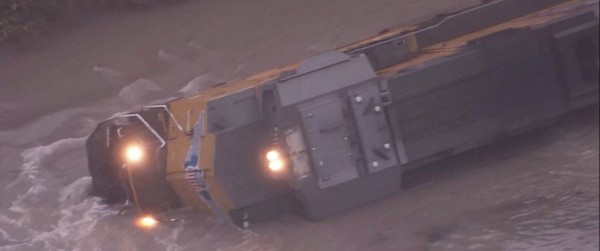
More than two feet ( 60 cm) of rain inundated parts of north and central Texas as storms rolled across the state this weekend, derailing a train and sweeping away at least one man, who remained missing.
The 64-car Union Pacific freight train hauling cement from North Texas to Houston derailed at 3:30 a.m. Saturday about 55 miles south of Dallas near Corsicana, according to Jeff DeGraff, a spokesman for the railroad.
No one was injured but two crew members had to flee the train as floodwaters rose around them.
“They did have to swim through some of the water to high ground to wait until the rescue crews could get out there,” DeGraff said.
More than half of the train cars — 46 — plus two locomotives derailed, DeGraff said.
He said none of the material the train was hauling was hazardous.
“There is some concern about some diesel fuel releasing from the locomotives, but we have an environmental team out there monitoring the water and the train itself, and if there is any sign release we have remediation materials on hand ready to deploy,” DeGraff said, including booms and absorption material
“As we speak they are assessing, we have several crews at the location to assess the cause and whether we will have any hazardous material issues,” said Navarro County Sheriff Elmer Tanner.
Tanner said areas of the surrounding county had been inundated with more than 26 inches (66 CM) of rain — “and it’s continuing.”
“It’s unheard of. I’ve been here my entire life, and I have never seen it like this,” Tanner said.
The heavy rain was produced by a storm system separate from Hurricane Patricia, which struck Mexico on Friday. However, authorities fear that the remnants of Patricia will bring more rain to Texas this weekend.
Flooding in the area closed Interstate 45 on Saturday, a major north-south artery between Dallas and Houston.
As flooding spread during the past 36 hours, 75 high-water rescues were made by teams deployed in the area, Tanner said.
He could not say how many homes may have flooded.
“Our priority right now is responding and protecting our citizens. We have not even begun to do damage assessments,” he said.
So far they have only had one injury reported among those rescued, he said: an elderly man who suffered hypothermia and was taken for treatment.
Matt Stalley, a meteorologist with the National Weather Service in Fort Worth, said Navarro County has been the hardest hit area of the state.
“That’s definitely been the epicenter for the rainfall we have seen, over 20 inches, the main bull’s-eye,” Stalley said.
The area was walloped by a combination of a big dip in the jet stream to the west, a steady flow of moisture north from the Gulf of Mexico and the remains of Hurricane Patricia, he said.
“The heaviest rain axis will continue to be just south of the Interstate 20 corridor, anywhere from Waco to Corsicana” late Saturday, he said, with at least a few more inches of rain through Sunday.
Dallas received nearly eight inches of rain, prompting minor flooding that closed 10 streets.
“The biggest concern by far has been the localized flash flooding due to he heavy rain,” Stalley said. “But we have seen some of the rivers responding, creeping up to moderate flood stages,” including portions of the Trinity and Sabine rivers. He expects the water level to taper off Sunday as the rivers drain into reservoirs that have space for runoff after a relatively dry summer.
In San Antonio, a 41-year-old homeless man was swept into a storm drain by floodwaters Saturday as he attempted to rescue his dog, according to Christian Bove, a spokesman for San Antonio Fire Department.
A rescue team searched the lake for a couple hours but were unable to find the man, Bove said.
“At that point, another storm cell came through town and they had to call off the operation,” he said. “It’s been pretty heavy rain since then, so we’re waiting for the rain to dissipate so we can resume that search.”
A woman walking with the man was safe, as was the dog, Bove said.
So far, the area has received up to a half foot of rain, he said, with localized flooding prompting two dozen road closures.
“We’re hoping the heaviest of it has come through, but we’ve been having regular conference calls with the National Weather Service and we plan to keep our emergency operations center staffed overnight,” Bove said.
LA TIMES
Leave a Reply
You must be logged in to post a comment.